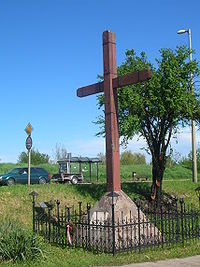| Battle of Szőreg | |||||||
|---|---|---|---|---|---|---|---|
| Part of the Hungarian Revolution of 1848 | |||||||
| |||||||
| Belligerents | |||||||
|
|
| ||||||
| Commanders and leaders | |||||||
|
|
| ||||||
| Strength | |||||||
|
34,000 men 108 cannon |
46,000 men 284 cannon | ||||||
| Casualties and losses | |||||||
|
500 dead and injured 400 taken prisoner | Unknown | ||||||
The Battle of Szőreg was a battle in the Hungarian Revolution of 1848, fought on 5 August 1849 at Szőreg, Hungary. The Hungarian troops, led by Henryk Dembiński, lost the battle against the Emperor’s troops, led by Haynau. Even though the Hungarian losses were relatively small in number, the defeat deeply affected the Hungarians' organisation and morale.
From Budapest to Szeged[]
On 22 July, Haynau started to move his troops towards Szeged from Budapest and on 24 July he followed them. He prepared for a hard and serious fight. Haynau precisely planned this battle: he divided his army of 46,000 people and 284 cannon into three parts. His plan was that he would take the Hungarian troops in a pincer movement at Szeged. Haynau sent his 3rd legion to Szabadka under the command of Georg Heinrich Ramberg. Haynau led his strongest legion (the Russian legion and his cavalry joining forces) and reached Kiskunfélegyháza without resistance. On 29 July Mór Perczel and his legion (26,438 people and 49 cannon) arrived at Szeged.
Before the battle[]
20,000 soldiers occupied the front at Szeged, which partly bordered the River Tisza. Most of the 4th Hungarian legion (10,500 legionnaires, 50 cannon) also went there from Bácska under Richard Guyon’s command, with Alessandro Monti’s legion (3,500 legionnaires, 8 cannon). The Emperor’s 1st legion occupied the Cegléd-Nagykőrös-Szolnok area under Franz Schlik’s command. They reached the River Tisza. Haynau gave orders to Ramberg and Schlik: Ramberg to move from Törökkanizsa and Schlik from Makó towards the Hungarian troops. Haynau wanted to start a frontal attack in the hope that the three legions jointly would destroy the Hungarian troops.
Dembiński thought that he lacked the power to defend Szeged and he retreated from the city on 1 August. He acted against other generals’ advice. Haynau was surprised when his legion occupied Szeged without a fight on 2 August. He ordered General Franz Liechtenstein to cross the River Tisza. Schlik had already crossed the river at Alpár on 1 August and was moving towards Makó. On 4 August came the first fight between Lenkey and the Emperor’s troops. Lenkey’s legion was only 7,000 strong, and most of them were inexperienced new recruits. Lenkey’s main task was to stop Schlik, who wanted to close off an escape route towards Arad (now in Romania).
Dembiński thought that if necessary he could escape towards to Turkey so he tried to cover his legion in the south. After he received news that the Austrian legions were battle-ready at Magyarkanizsa, he sent Guyon to Törökkanizsa (in Romanian: Noul Cnezat, now in Serbia) on 2 August. The next day Dembiński also sent Monti’s legion there. But Dembiński gave this order a little too late to be of use, and all he could do was debilitate the enemy on the Szentiván–Szőreg–Deszk front line, because Ramberg had crossed the River Tisza on 5 August. Dembiński also failed to stop Ludwig von Benedek, who had crossed the river on 3 August. Dembiński decided to attack, but his decision came too late, because the area had already been reinforced by the enemy. After this he redeployed his troops to Szőreg. He planned this as a defensive fight and dug his cannon into the embankment.

This cross of remembrance at Kamaratöltés was erected by the Szeged Municipal Council on the 150th anniversary of the battle.
The battle[]
On 4 August Haynau's troops crossed the river and the next day advanced towards Dembiński. After Dembiński received the news that Ramberg had broken through and crossed the river, and was very close to the Hungarians, he prepared to retreat.
Haynau's legion was approximately 25,000 strong with 160 cannon, Dembiński's was 34,000 strong with 108 cannon. Dembiński didn't intend to use all of his cannon and he sent most of their surplus munitions en route for the planned retreat.
Haynau bypassed the Hungarian troops and Dembiński deployed his cavalry too late, even though Fülöp Bechtold was only advancing very slowly. Haynau started his attack at the front line and after an hour and a half's battle he displaced the Hungarians. The Hungarians tried to attack. After Bechtold arrived and started to fight Dembiński's troops, Dembiński had to retreat. Polish and Italian legions, and Arisztid Dessewffy's, covered Dembiński and his troops during the retreat.
Summary[]
The battle finished in the evening and even though the Hungarian losses were relatively small in number (500 dead and injured, 400 prisoners), the defeat deeply affected the Hungarians' organisation and morale. The situation was more different at Szőreg than the battle at Kápolna, where the Hungarians waited for the enemy's cavalry and had their revenge. Whereas at Káplona the Hungarians engaged with the enemy’s cavalry, at Szőreg they deserted.
The refugee troops got help from the legions at Beba, Dudeștii Vechi and Lenauheim (now Cetad), all of the cities are now part of Romania.
References[]
Sources[]
- Bona, Gábor (1996). "Az 1848-49. évi szabadságharc története ("The history of the Hungarian Revolution of 1848-49")" (in Hungarian). Videopont. ISBN 963-8218-20-7.
- Hermann, Róbert (2001). "1848-1849 a szabadságharc hadtörténete ("Military History of 1848-1849")" (in Hungarian). Korona. ISBN 963-9376-21-3.
| ||||||||||||||||||||||||||
The original article can be found at Battle of Szőreg and the edit history here.